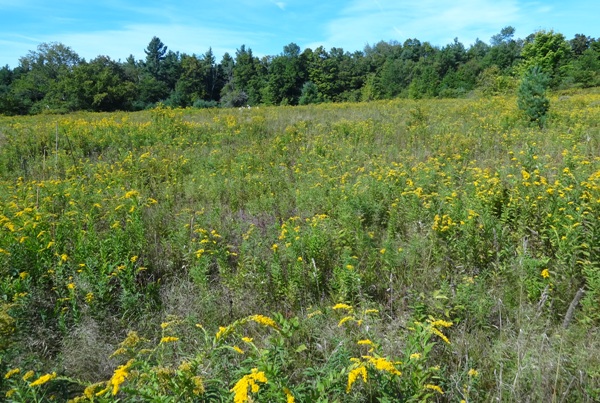The last day of August, and as with every year, my sinuses start to drain and sneezing increases. Autumn is a beautiful time of year, but some of us pay the price for the nice temperatures and lower humidity. Drive down any country road and you’ll see the yellow plague developing. This would be all the Goldenrod and Ragweed coming into bloom.

I'm sneezing just looking at this picture.
Massive amounts of pollen are dumped into the southwest Ohio air making those of us with allergies miserable. Add to that leaf mold and dust, other molds, and… well you get the picture. Many of our four-legged friends also suffer this time of year.
Dogs and cats usually exhibit inhalant allergies with intense itching of their skin. We are also seeing an increase in respiratory symptoms each year. If left untreated, the scratching causes further irritation and eventual bacterial (usually Staph.) secondary infections. Likewise, respiratory symptoms can evolve into sinus infections, bronchitis, and possible pneumonia.

Bless you.
So, what to do?
First make sure your pet is flea-free by keeping them on a strict flea prevention program. We have excellent products and recommendations.
Get the problem checked by us in the early stages. The problem can be controlled faster and easier the sooner you bring your pet in. Also, your pet will not suffer with the pain and intense itching of secondary infections. Some of these infections can be serious health risks.
Follow our instructions for treatments, both orally and topically, and finish all medications unless told otherwise.
Show up for your recheck appointment. We wouldn’t make it if it wasn’t necessary. At these appointments we will check the progress and probably continue some of the treatments. We want the antibiotic therapy to continue at least 2 weeks beyond symptoms ceasing.
Depending on how long the weather stays warm, don’t be surprised if a relapse occurs. If so, we will repeat all the above or what is needed dependant on your pet’s case.
What if the symptoms continue into the winter? This is not unusual because just as the skin is healing it gets slapped with dry winter air. Temporary continuation of treatments usually resolve this. Should symptoms continue to recur we usually will recommend diagnostics for other problems such as food allergies, thyroid dysfunction, etc.
Then wait until next September to do this all again!
Can this be prevented?
Yes and no. If the problem is confined to a few weeks a year we usually just treat the symptoms. However, if the symptoms persist for longer periods or are very intense we sometimes recommend allergy testing. This requires a commitment by you, because based on results, you will give allergy shots weekly, for the lifetime of your pet. An oral form has been developed, but the jury is still out on effectiveness. Often this does not totally abate symptoms, but the milder symptoms are easier to control.
Other preventative measures include staying indoors as much as possible this time of year, and yes, we know this is next to impossible with Labs and other large hunting/working dogs. Keep windows closed and run air conditioning as much as possible. And finally, weekly baths to remove pollens from the haircoat.
So, you don’t have to be kept up all night from your dog scratching and your cat’s strange, changed behaviour. Don’t wait until you see red patches indicating secondary infection. Start treatments early and everyone can still enjoy this nice weather before the impending winter.
Dr. Jerry Miller
Lifetime Pet Centers of New Richmond & Williamsburg